5. Working hours
Working hours change quite slowly. Working hours and hours worked fluctuate according to changes in employment and in the structure of the wage and salary earning population. For instance, if part-time work becomes more widespread than full-time work, the number of average weekly working hours falls. Working hours also vary by industry and occupation, as well as by employer sector.
The concepts of working hours used in statistics are regular weekly working hours, hours worked per week and hours worked per year. Regular weekly working hours mean the hours an employee normally works inclusive of regular overtime hours. The average of regular weekly working hours is influenced by the form or working hours, i.e. whether full-time or part-time work is concerned. Hours worked per week are lowered by absences during the survey week and raised by overtime and extra hours worked. Hours worked per year is a calculated concept in which the number of all hours worked in a year are divided by the average number of employed persons or employees.
5.1 Most common working week is 35 to 40 hours
The vast majority (73 per cent) of employees worked a regular week of 35 to 40 hours in 2009. There was very little variation in this between different employee groups. Only one in four of self-employed persons and assisting family members worked a regular week of 35 to 40 hours.
Figure 6. Share of persons working a regular week of 35 to 40 hours by socio-economic group in 2009, %
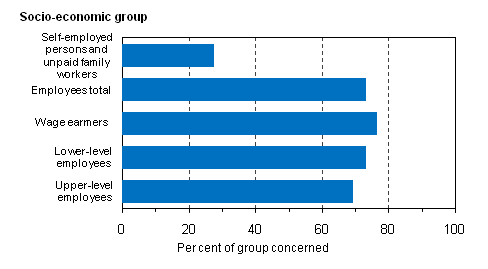
Figure 7 shows the shares of employees and self-employed persons with a short working week of under 35 hours in 2009. Approximately 17 per cent of employees had a short working week. Around one-fifth of lower-level employees had a short working week. Short working weeks were less widespread among upper-level employees. Those with a short working week most typically worked 30 to 34 hours per week. One self-employed person and assisting family member in four had a short working week.
Figure 7. Share of employees working regularly a short working week of 1 to 34 hours by socio-economic group in 2009, %
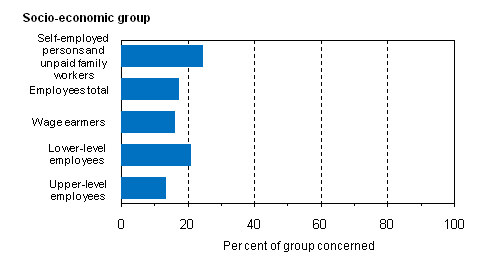
Approximately nine per cent of employees had a long working week of over 40 hours. Among all employees, upper-level employees had most often a long regular working week. Of them17 per cent did long weekly working hours. Long regular weekly working hours were most widespread among self-employed persons and assisting family members, of whom almost 46 per cent regularly worked long hours. (Figure 8.)
Figure 8. Share of employees working regularly a long working week of over 40 hours by socio-economic group in 2009, %
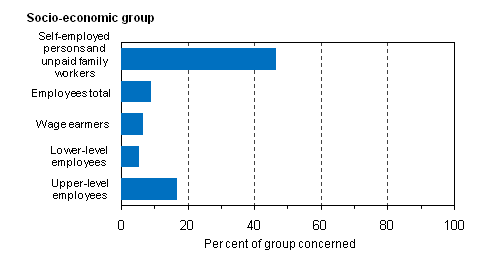
5.2 Men’s working week in full-time employment longer than women’s
Average number of regular working hours per week in the main job have hardly changed at all between 2008 and 2009. Employees’ average regular weekly working hours totalled 36.5 hours and their hours worked 35.2 hours per week. The longest weekly hours were worked by self-employed persons whose average regular weekly hours totalled 43 and hours worked 41,6 hours per week in 2009. Men’s regular working hours and hours worked are longer than women’s (table 1). Hours worked are shortened by holidays and other absences and lengthened by worked overtime hours.
Table1. Average of employees’ regular weekly working hours and hours actually worked per week in full-time and part-time work in 2009
| Regular working hours | Hours actually worked | |||
| Full-time work | Part-time work | Full-time work | Part-time work | |
| Total | 39.0 | 19.8 | 37.4 | 20.2 |
| Men | 39.9 | 18.3 | 38.5 | 19.0 |
| Women | 38.1 | 20.5 | 36.3 | 20.6 |
Managers’ and senior officials’ regular working hours per week in full-time work was on average 41.5 hours (Figure 9). Apart from them, only process and transport workers do a regular working week of slightly over forty hours. Office and customer service workers do the shortest working week.
Figure 9. Average of employees’ regular weekly working hours in full-time work by occupation in 2009
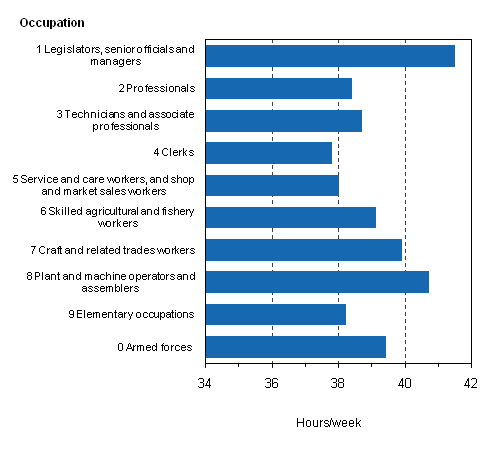
5.3 Annual hours worked decreased in 2009
Figure 10 compares hours worked per year by employer sector. In recent years, annual hours worked have been almost identical in the private and central government sectors. Hours worked per year decreased clearly last year, which could be explained by the economic situation which lead to temporary lay-offs and shortening of working hours. Annual hours worked also decreased in the central government sector.
In the local government sector hours worked per year are clearly below those in other sectors, and this has hardly changed at all.
Figure 10. Annual hours worked of employees by employer sector in 1997–2009
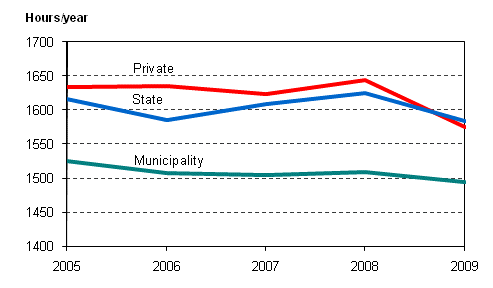
The number of women’s hours worked per year is around 200–250 lower than men’s. Women, for instance, work more often part-time than men. Family leaves also shorten women’s hours worked more than men’s. Two-thirds of all employees working part-time are women.
The difference between women and men in the number of hours worked was largest in hotel and restaurant activities last year: female employees’ working year was over 300 hours shorter than men’s. Both men’s and women’s annual hours worked diminished last year. Men’s annual hours worked decreased by an average of 70 hours and women’s by just under 40 hours between 2008 and 2009.
5.4 Women do more shift work than men
Saturday and Sunday work and shift work represent working hours that deviate from the usual daywork that is done on weekdays. Around 17 per cent of employed persons and 14 per cent of employees did Saturday work during the survey week in 2009 (Table 2). Approximately 12 per cent of employed persons and 9 per cent of employees did Sunday work during the survey week. More than one in four of female employees and around one in five of men did shift work.
Table 2. Share of employed persons and employees having done shift work and week-end work during the survey week in 2009, %
| Employed | Employees | ||||
| Saturday work | Sunday work | Saturday work | Sunday work | Shift work | |
| Total | 17 | 12 | 14 | 9 | 23 |
| Men | 17 | 11 | 12 | 8 | 19 |
| Women | 18 | 12 | 16 | 11 | 27 |
Source: Labour force survey 2009. Statistics Finland
Inquiries: Anna Pärnänen (09) 1734 2607, Päivi Keinänen (09) 1734 3416, tyovoimatutkimus@stat.fi
Director in charge: Riitta Harala
Updated 1.6.2010
Official Statistics of Finland (OSF):
Labour force survey [e-publication].
ISSN=1798-7857. 15 2009,
5. Working hours
. Helsinki: Statistics Finland [referred: 9.1.2026].
Access method: http://stat.fi/til/tyti/2009/15/tyti_2009_15_2010-06-01_kat_005_en.html

